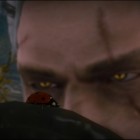Well, is there anyone who doesn’t know the very entertaining TrackMania series? It never was a really illustrious game, but you could pass some hours/days excellently with it, especially if you could get some friends to it. If you don’t know it, I would like to introduce a fully free episode of the series, called TrackMania: Nations Forever. Before dissection I have to lay down something: This series is not noted for its excellent crash model or simulation of reality. There is no reality, because you can hit any hairpin bend at 200. But reality is not the point – fine game experience and instant action rather is (of course, if you are a fan of simulation, maybe you won’t like it that much, but this is a personal problem – Garcius). As Florent Castelnerac, producer of Nadeo said, they never had planned any tuning option, because simple things are more amusing in themselves. That means you don’t have to start a career (you don’t start from zero), but you can blast right into the middle of the sauce, and prove what you want on a track. 3, 2, 1 AND GOO! The manu is simple, and after setting resolution, sharpness and anything you want, the party is on. You can choose a difficulty setting from White, Green, Blue, Red or Black — evidently Black is the hardest one. And on every difficulty setting there are lots of tracks waiting for you to conquer them. There are around 85-90 (!) tracks in the game. Before starting a race you have to decide what type of medal you want to get: gold, silver or bronze. It is like a second difficulty setting for the given track. I think everyone realized the goal of the game: to be the first who wheels into the finish. Regarding the opponents, soon it will be clear that they are not real but so-called “ghost cars”. Perhaps you cast a questioning glance to the display now and wondering about what can be good in it? Exactly just that: you cannot crash into your opponents, so even bad players don’t have to restart the race after one or two minutes. You...
Tomb Raider Trilogy: Legend, Anniversary, Underworld

2014. nov. 13.
Considering that the story connects them tightly, I decided to review the Crystal Dynamics trilogy of the Tomb Raider series in one block. Good and bad can be said about it in the same time, although on the whole I have a mostly pos opinion. There were some moments when I sent allt the developers back into their mothers for nine months, but all’s well that ends well. Over the hills and far away there was a jumpy-crawly style of games that was born in the ancient times. Today’s youngsters mostly doesn’t know what they play in real. In those times saving a princess was enough motivation for starting an adventure, and there were no visual effects and story twists, but platformers came alive and conquered the world.Donkey Kong (1981), Mario Bros (1983) and Prince of Persia (PoP, 1989) haven’t gone out of fashion for thirty years now – at best, some of them were renewed a little. The first Tomb Raider in 1996 had infiltrated this gaming trend, and regarding gameplay it had been similar to PoP. Lara Croft is gifted with the abilities of a goddess, and her first climb-jump-grab-shoot adventure turboed by 3D graphics had been so good that it hadn’t only created a brand, but practically it had renewed the whole platformer genre, and it had made the bed for a heap of other games. I don’t go further into the details of history, beícause I don’t wanna write a book about the advancement of platformer games. The point is; after changing the developer team Eidos released Tomb Raider: Legend (TR:L) in 2006, and it made its way to me. Continually, Anniversary (TR:A) came in 2007, and Underworld (TR:U) in 2008, and these made a complete trilogy with the first installment. They showed Lara Croft as she “leapt in the tiny room” and met her mother, whom she “missed for quite a while.” In the intro video of TR:L Lara’s mom does exactly what is banned and written on every warning sign at ancient ruins nowadays; touches things and takes them from their places. To be more exact, it is a stone sword, or – not incidentally – the key...
Editorial Note: Where Are You, CRPG?
I met a guy, someone’s someone, a young one. We talked some, mostly about games, and it turned out, I quote it: “I only played one RPG, Diablo II.” I told him that’s not an RPG, as I know, it was only diversified with a character development system. For this he said, who the f*ck am I to know better? I answered no one, no one, steady on, let D2 be an RPG. That was all. But in real, who am I to tell an opinion? The boy was around sixteen, and I’m playing pen and paper and computer RPGs for seventeen years now. There are approx. 20-22 different role-playing games laying on my shelves with 5-6 strategy games. Some of them are written by my own hand because I just borrowed the originals to translate them for me and my friends. But it is surely more interesting for a Gamedroid-reader that CRPGs were not waiting for long. I was a third grader in high school when I got my first desktop computer, a 286 brought by dad for a piece of homemade salami. It’s display was a small mono Unost television tinkered to be acceptable for the 4-color CGA. Particularly the PC was able to force 16 shades of gray out of this configuration. Well, this stuff saw a lot of interesting thing like STUNTS and POP 1-2, besides such curiosities as Ultima IV, Death Knights of Krynn and at least two parts of the Eye of the Beholder series. So, maybe there are some basic experience behind my opinion. Well, this is enough from the whining framed introduction. Let nostalgia come. Richard Garriott counts as the creator of CRPG with a cute little software titled Akalabeth, which was like ten white lines on black background. Like a dungeon crawling with stickmen. Then nine chapters of the Ultima series was developed from this – one of the most popular Ultimas, the fourth one can be found at the Doggies (www.homeoftheunderdogs.net) in a renewed version. I don’t guarantee it works on Win7, but if it does, you can get to know the feeling of Pen&Paper role-playing games from it. Take, for example, that tiny...
The Witcher 2

2014. nov. 13.
Sometimes the question comes into the geek mind: What may you expect from your favorite genre on the actual level of technology? Then a game comes and by overdoing the expectations it pushes this “actual level of technology” into your face. My favorite genre is CRPG, and in their times I considered these games amazing (not going back to the ancient times of gaming): Baldur’s Gate (1998), Arcanum (2001), Morrowind (2002), Arx Fatalis (2003), Fable (2004), a Gothic 3 (2006), Fallout 3 (2008), and now The Witcher 2. In the end of the 90s, Baldur’s Gate showed us what quality means in the CRPG genre. It has predecessors and successors alike, bot for its complex story and excellent playability made it one of the most popular, and later, one of the most remembered games. The second one on the list, Arcanum was not just only freeing the term of “walkable area”, but it offered a flexible development system and can be proud of the most complex dialog system to date. Unfortunately, it was full of bugs. With its huge world Morrowind too was ranked among the free roam role-playing games (like all The Elder Scrolls series). Its graphics (in its time), its system and story served high quality game experience. In spite of this the unlit world of Arx Fatalis brought the style of dungeon crawling back, but in the same time it showed such a movement-based spellcasting system that didn’t just made us forget the narrowness of caves and tunnels, but it seems as if the experimenter mood behind the idea would be missing from newer games. Fable. We can say Fable contained everything that a CRPG must have regarding social opportunities, and that made it the most stylish game on the world. The next one, Gothic 3 showed an exceptional combat system. For example, I was unable to melee effectively, while my kick boxer friend could easily kill even three foes in the same fight, irrespectively of their level. It was because with arches and range estimation in archery, and quick dodges, step-ins and precise strikes the combat system of Gothic 3 stood relatively close to simulating reality. Of course, if you...
The Secret World — Real Virtuality

2014. nov. 13.
Did you ever think about what a virtual reality would be today, at your home, in a form realizable and available on any day? Hereby I mean no virtual reality in general but in a specialized form of virtual world that is not separable easily from the real one. I mean it is a virtual environment that can be considered as another world, but it mixes with our current environment. Well, I was thinking about this a lot years ago, and I believe that good (and sometimes bad) ideas can emerge in more than one head worldwide, and in the same time, of course. (For skeptics: Having no scientific explanation for something doesn’t mean that the given thing cannot exist, does it?) This real virtuality idea could be such a thing because Funcom made it and released it summertime, this year – however, the idea had the come up for this years ago, maybe in that time when I was thinking about it too. I can’t remember when had an MMO such an impressive effect on me. Anno the ad of The Secret World was considered special; besides the usual e-mail newsletters they started a Facebook application titled Secret War, in which you had to use your social network to get points and win ingame items, and a closed beta keycode if you reached the maximum. After this I was waiting for the game with the usual mix of disinterest + mild curiosity. I was watching only a few of the trailers, and I paid attention to the big words of advertising only with one eye. Then I got a beta key and started it. Perhaps the first hours will show you no novelty. Seasoned MMO-players can go forward by watching only the quality, which is good enough, 4/5 in the MMO category. So, you start in a city environment with a tutorial, then you make a jump into the Agartha, which is something like a fugue dimension with much shorter distances between locations. The first such location is the town of Kingsmouth, full of zombies. Zombies again, yes? If you can live with this gnawed bone, you may dive into the details that...

Legutóbbi hozzászólások